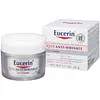Eucerin Q10 Anti-Wrinkle Face Lotion with SPF 15 Versus Neutrogena Rapid Wrinkle Retinol Regenerating Cream
What's inside
What's inside
 Key Ingredients
Key Ingredients

 Benefits
Benefits

 Concerns
Concerns

 Ingredients Side-by-side
Ingredients Side-by-side

Ethylhexyl Methoxycinnamate 7.5%
UV AbsorberEthylhexyl Salicylate 3%
UV AbsorberBenzophenone-3 3%
UV AbsorberWater
Skin ConditioningGlycerin
HumectantCyclomethicone
EmollientCetyl Alcohol
EmollientMethylpropanediol
SolventAlcohol Denat.
AntimicrobialCetearyl Isononanoate
EmollientGlyceryl Stearate Se
EmulsifyingPalmitic Acid
EmollientStearic Acid
CleansingUbiquinone
AntioxidantPanthenol
Skin ConditioningTocopheryl Acetate
AntioxidantCaprylic/Capric Triglyceride
MaskingOctyldodecanol
EmollientPhenoxyethanol
PreservativeEthylhexylglycerin
Skin ConditioningPiroctone Olamine
PreservativeCarbomer
Emulsion StabilisingSodium Hydroxide
BufferingDisodium EDTA
Ethylhexyl Methoxycinnamate 7.5%, Ethylhexyl Salicylate 3%, Benzophenone-3 3%, Water, Glycerin, Cyclomethicone, Cetyl Alcohol, Methylpropanediol, Alcohol Denat., Cetearyl Isononanoate, Glyceryl Stearate Se, Palmitic Acid, Stearic Acid, Ubiquinone, Panthenol, Tocopheryl Acetate, Caprylic/Capric Triglyceride, Octyldodecanol, Phenoxyethanol, Ethylhexylglycerin, Piroctone Olamine, Carbomer, Sodium Hydroxide, Disodium EDTA
Water
Skin ConditioningPentaerythrityl Tetraethylhexanoate
EmollientGlycerin
HumectantDimethicone
EmollientPPG-15 Stearyl Ether
EmollientStearyl Alcohol
EmollientCetearyl Alcohol
EmollientButylene Glycol
HumectantGlyceryl Behenate
EmollientCeteareth-20
CleansingIsohexadecane
EmollientDimethicone Crosspolymer
Emulsion StabilisingCyclopentasiloxane
EmollientCellulose
AbsorbentSodium Polyacrylate
AbsorbentPhenoxyethanol
PreservativeCaprylyl Glycol
EmollientSodium Acryloyldimethyltaurate/Vp Crosspolymer
Emulsion StabilisingPolyacrylamide
C13-14 Isoparaffin
EmollientChlorphenesin
AntimicrobialPolysorbate 20
EmulsifyingHydrolyzed Myrtus Communis Leaf Extract
Skin ProtectingRetinol
Skin ConditioningBHT
AntioxidantSodium Hyaluronate
HumectantDisodium EDTA
Sodium Hydroxide
BufferingLaureth-7
EmulsifyingAscorbic Acid
AntioxidantWater, Pentaerythrityl Tetraethylhexanoate, Glycerin, Dimethicone, PPG-15 Stearyl Ether, Stearyl Alcohol, Cetearyl Alcohol, Butylene Glycol, Glyceryl Behenate, Ceteareth-20, Isohexadecane, Dimethicone Crosspolymer, Cyclopentasiloxane, Cellulose, Sodium Polyacrylate, Phenoxyethanol, Caprylyl Glycol, Sodium Acryloyldimethyltaurate/Vp Crosspolymer, Polyacrylamide, C13-14 Isoparaffin, Chlorphenesin, Polysorbate 20, Hydrolyzed Myrtus Communis Leaf Extract, Retinol, BHT, Sodium Hyaluronate, Disodium EDTA, Sodium Hydroxide, Laureth-7, Ascorbic Acid
 Reviews
Reviews

Ingredients Explained
These ingredients are found in both products.
Ingredients higher up in an ingredient list are typically present in a larger amount.
Disodium EDTA plays a role in making products more stable by aiding other preservatives.
It is a chelating agent, meaning it neutralizes metal ions that may be found in a product.
Disodium EDTA is a salt of edetic acid and is found to be safe in cosmetic ingredients.
Learn more about Disodium EDTAGlycerin is already naturally found in your skin. It helps moisturize and protect your skin.
A study from 2016 found glycerin to be more effective as a humectant than AHAs and hyaluronic acid.
As a humectant, it helps the skin stay hydrated by pulling moisture to your skin. The low molecular weight of glycerin allows it to pull moisture into the deeper layers of your skin.
Hydrated skin improves your skin barrier; Your skin barrier helps protect against irritants and bacteria.
Glycerin has also been found to have antimicrobial and antiviral properties. Due to these properties, glycerin is often used in wound and burn treatments.
In cosmetics, glycerin is usually derived from plants such as soybean or palm. However, it can also be sourced from animals, such as tallow or animal fat.
This ingredient is organic, colorless, odorless, and non-toxic.
Glycerin is the name for this ingredient in American English. British English uses Glycerol/Glycerine.
Learn more about GlycerinPhenoxyethanol is a preservative that has germicide, antimicrobial, and aromatic properties. Studies show that phenoxyethanol can prevent microbial growth. By itself, it has a scent that is similar to that of a rose.
It's often used in formulations along with Caprylyl Glycol to preserve the shelf life of products.
Sodium Hydroxide is also known as lye or caustic soda. It is used to adjust the pH of products; many ingredients require a specific pH to be effective.
In small amounts, sodium hydroxide is considered safe to use. However, large amounts may cause chemical burns due to its high alkaline.
Your skin has a natural pH and acid mantle. This acid mantle helps prevent harmful bacteria from breaking through. The acid mantle also helps keep your skin hydrated.
"Alkaline" refers to a high pH level. A low pH level would be considered acidic.
Learn more about Sodium HydroxideWater. It's the most common cosmetic ingredient of all. You'll usually see it at the top of ingredient lists, meaning that it makes up the largest part of the product.
So why is it so popular? Water most often acts as a solvent - this means that it helps dissolve other ingredients into the formulation.
You'll also recognize water as that liquid we all need to stay alive. If you see this, drink a glass of water. Stay hydrated!
Learn more about Water